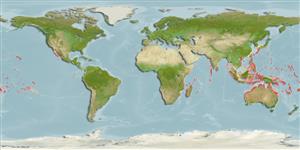Environment: milieu / climate zone / depth range / distribution range
Ecología
marino asociado a arrecife; rango de profundidad 0 - 4 m (Ref. 89972). Tropical
Indo-Pacific: East Africa to the Hawaiian, Line and Ducie Islands, north to Marcus Island.
Tamaño / Peso / Age
Maturity: Lm ? range ? - ? cm
Max length : 12.0 cm SL macho / no sexado; (Ref. 9710); 9.0 cm SL (female)
Espinas dorsales (total): 12 - 13; Radios blandos dorsales (total): 18-20; Espinas anales 2; Radios blandos anales: 20 - 21. Body with 6-7 irregular bands (Ref. 4404). Dark spot present distally on anterior part of dorsal fin; females with dark spots on vertical fins, males more evenly colored (Ref. 4404).
Inhabit shallow shore line water of intertidal reef flats from 0.5 to 1.5 m depth where the substrate consists of a thin carpet of algal turf and sand (Ref. 205). Benthic (Ref. 58302). Oviparous. Eggs are demersal and adhesive (Ref. 205), and are attached to the substrate via a filamentous, adhesive pad or pedestal (Ref. 94114). Larvae are planktonic, often found in shallow, coastal waters (Ref. 94114).
Life cycle and mating behavior
Madurez | Reproducción | Puesta | Huevos | Fecundidad | Larva
Oviparous, distinct pairing (Ref. 205).
Springer, V.G. and J.T. Williams, 1994. The Indo-West Pacific blenniid fish genus Istiblennius reappraised: a revision of Istiblennius, Blenniella, and Paralticus, new genus. Smithson. Contrib. Zool. 565:1-193. (Ref. 9962)
IUCN Red List Status (Ref. 130435)
Threat to humans
Harmless
Human uses
Pesquerías: sin interés; Acuario: Comercial
Más información
ReferenciasAcuiculturaPerfil de acuiculturaRazasGenéticaElectrophoresesheritabilidadEnfermedadesProcesamientoNutrientsMass conversion
ColaboradoresImágenesStamps, Coins Misc.SonidosCiguateraVelocidadTipo de nataciónSuperficie branquialOtolitosCerebrosVisión
Herramientas
Special reports
Download XML
Fuentes de Internet
Estimates based on models
Preferred temperature (Ref.
123201): 23.6 - 29.3, mean 27.5 °C (based on 1314 cells).
Phylogenetic diversity index (Ref.
82804): PD
50 = 0.5020 [Uniqueness, from 0.5 = low to 2.0 = high].
Bayesian length-weight: a=0.00741 (0.00335 - 0.01640), b=3.02 (2.83 - 3.21), in cm total length, based on LWR estimates for this (Sub)family-body shape (Ref.
93245).
Nivel trófico (Ref.
69278): 2.8 ±0.3 se; based on size and trophs of closest relatives
Resiliencia (Ref.
120179): Alto, población duplicada en un tiempo mínimo inferior a 15 meses (Preliminary K or Fecundity.).
Fishing Vulnerability (Ref.
59153): Low vulnerability (10 of 100).
Nutrients (Ref.
124155): Calcium = 142 [68, 253] mg/100g; Iron = 0.786 [0.430, 1.425] mg/100g; Protein = 17.9 [16.6, 19.1] %; Omega3 = 0.0698 [, ] g/100g; Selenium = 18 [8, 42] μg/100g; VitaminA = 120 [28, 516] μg/100g; Zinc = 2.57 [1.65, 3.85] mg/100g (wet weight);
